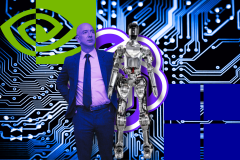Since the onset of the pandemic, organizations across the world have drastically accelerated their digital transformation timetables to remain relevant and keep employees engaged amid changing market dynamics. However, many have failed to fully achieve the business outcomes enabled by successful digital transformation.
At a time when competition in every industry is stronger than ever, that’s a major missed opportunity.
The Reason Behind Transformation Failures
In order to reap the full benefits of digital transformation, it is important to align skills, operations, knowledge, and culture to leverage digitalized work habits and new technologies. Research shows that a lack of this alignment, or digital maturity, is one of the most critical factors in determining why so many organizations fail to meet their digital transformation goals.
The good news? Achieving digital maturity is well within reach for organizations that are willing to put in the work.
What Is Digital Maturity?
Digital maturity is the ability to adapt people, experiences, and businesses to new platforms and tools in order to maximize the value that is created through successful digital transformation. As your transformation ramps up, it’s vital to get a realistic temperature of the digital maturity within your organization so you can avoid common pitfalls.
The more mature your organization’s digital culture is, the more likely it is to succeed in full-scale transformation. Attaining digital maturity means your company can adjust to changes quickly, avoid costly technical delays, and see improved operations alongside heightened efficiency.
Putting People First — Always
So what’s the secret to attaining this optimal level of maturity? First and foremost, establishing a digitally mature culture requires a shift in mindset and the implementation of practical strategies. Organizations must prioritize people over technology and create an environment that enables both employees and the business to thrive.
The benefits of establishing a digitally mature culture include enhancing employee satisfaction and engagement, improving retention rates, and reducing attrition. A people-first approach also attracts top talent, particularly among younger generations who expect organizations to have digital maturity.
The Far-Reaching Effects of People-Centricity
By fostering an environment that values employees and leverages technology effectively, organizations become more attractive to prospective employees. And those that don’t prioritize this type of people-first approach? They will lose out on top talent.
Beyond the obvious employee satisfaction metrics, a people-centric culture promotes growth and encourages continuous learning, all while enabling employees to adapt to change more effectively. This agility drives innovation, productivity, and competitiveness in the digital landscape.
Evaluating the Characteristics of a Digitally Mature Culture
Let’s look at the ingredients that bring a successful digital transformation to life. It’s helpful to evaluate these four characteristics to see where your organization’s digital maturity stands:
Innovation: You should take into consideration how easy it is for your current employees to generate and implement creative ideas. It is critically important to foster a culture that truly encourages and rewards innovations. Make sure that you have the platforms and the resources needed for employees to contribute their ideas. And remember to “decriminalize” so-called failures. Great ideas require plenty of trial and error.
Flexibility: You will need to evaluate the flexibility of your organization and how well it adapts to change so you can determine if there is room for adjustments and if you have the ability to request additional time. It’s important to promote an environment that strives for successful digital transformation and an advanced digital culture — one that encourages employees to adapt to new processes and technologies.
Collaboration: Assess if you’ve created an atmosphere that is conducive to collaboration among all team members. Your organization should encourage open communication and knowledge sharing to keep everyone moving in the same direction. This extends to leadership as well; leaders should be transparent about the company’s digital transform strategy and be open to answering questions and considering new ideas from employees.
Continuous learning: Encouraging ongoing education and training in the digital transformation journey is crucial. Evaluate if you have the proper resources and processes in place to do so. You want your employees to regularly engage in various types of learning to ensure they have a clear understanding of the digital culture, processes, and technologies used within your organization. Fostering this type of culture also shows employees that you are invested in their growth, increasing satisfaction and the ability to attract new talent.
How Organizations Can Ensure Successful Digital Transformation
There are several strategies you can implement in order to make your digital transformation successful while prioritizing your people. The most effective strategies include the following:
1. Take a Bottom-Up Approach.
Your employees play an integral part when it comes to implementing a successful digital transformation. For this reason, it is in your best interest to implement a bottom-up approach and allow all employees to play an active role in the process right from the beginning. When everyone is onboard and rowing in the same direction, the destination becomes a lot easier to reach.
2. Recognize Your Current State of Digital Maturity.
It is important for you to assess how digitally mature your organization is. There’s no need to sugarcoat the findings. Be realistic. Determining the current maturity level among your employees can help you hone in on the organization’s acceptance and willingness to make the necessary changes. A great way to do this is to survey your employees: What do they want from your digital transformation? How are they engaging with new processes? Taking the pulse of the organization provides valuable feedback needed to make future adjustments.
3. Overcome Resistance to Change.
One of the biggest challenges to successful digital transformation is gaining buy-in from those who are wary of the transition. However, overcoming this resistance to change is key to ensuring you are able to make the transformation work. One of the best things that you can do to help overcome such resistance is to create a support system for staff and leadership. Create an environment of open communication where you can discuss how digital maturity can be viewed as an opportunity instead of a threat. Emphasize the end goal if necessary; the company’s vision is X, and improving digital maturity is the way to achieve that.
Make no mistake, implementing these strategies does take dedicated time and effort. But doing so can help to ensure your organization is prepared to prioritize and support employee engagement amid constant change. Following the above steps will do wonders for enhancing your digital maturity and, ultimately, make your digital transformation more successful. There’s no better time to act than now.


















